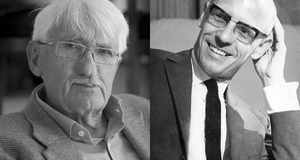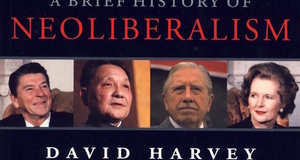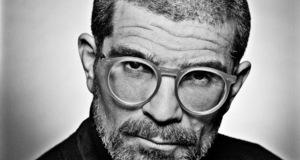|
The Contemporary Global Public Sphere as Reincarnation of Habermas' Bourgeois Society
Furthermore as Bourdieu demonstrates free time is also an important commodity linked to both cultural and social capital. Participation in a rational critical discourse demands free-time to participate in debate, to formulate and even author your own arguments takes a lot of what Bourdieu defines as “labour-time,” a universal measure of capital which is converted into other forms. The accessibility of information is as exclusive today, as is the labour-time necessary to consume and evaluate it. Just as in the bourgeois days information and knowledge are the preserve of a select few in society and are essential to participation in a parochial discourse.
In Habermas’ ideal of a bourgeois public sphere this discourse took place in the early salons and coffee houses between 1680 and 1730. A crucial conduit of this public sphere was its communication of information over a large geographical distance facilitating critical debate amongst a new social group. This was achieved by the development of a commercialised press initially taking the form of “moral weeklies” and “periodical essays” which emerged directly from the coffee houses themselves. Periodicals and journals were also fundamental in facilitating this discourse with titles such as the Spectator, Guardian and Tatler publishing letters in their editorials. Habermas tells us through these publications “the public held up a mirror to itself” and how some of the content even featured essays criticising societies many social problems.
The replication and distribution of this early literature was essential in facilitating the rational critical debate which began to question and challenge authority. This is Habermas’ paradigm of a public sphere in its purest form, the facilitator of critical thought uncorrupted by mass media bias. As already established this debate was corrupted in the sense that the subject matter was limited to specific issues concerning only a minority in society, Habermas concedes this debate was primarily about “the protection of a commercial economy.” Just like today the idea of a rational critical debate being inclusive and representative is extremely idealistic.
In our contemporary public sphere a pure public discourse unmolested by media manipulation is still the preserve of an affluent few in a global society. Through the communication methods of modern technology rational critical debate continues through many similar mediums as in the eighteenth century. Online periodicals and journals are still used to stimulate and articulate a discourse on economic and political issues, a phenomenon still completely out of reach of the majority of people around the world. Even information in more accessible mediums such as quality newspapers and the blogosphere require a lot of cultural capital to understand and labour-time to consume. Only a tiny proportion of the global population possesses the different forms of capital necessary to access such quality information.
Today, just as in the bourgeois society of old, many publications contain information and debates on issues like global inequalities and poverty, however just as back in the eighteenth century these topics are simply abstract issues which provide interesting topics of discussion but not of genuine concern. The primary concern of this group is the same as it was during the days of mercantilist capitalism: ensuring the global political economy facilitates free market capitalism. Craig Calhoun’s critique of Habermas’ bourgeois public sphere is just as relevant today as in the eighteenth century, it consisted of, “mainly educated, propertied men, and they conducted a discourse not only exclusive of others but prejudicial to the interests of those excluded.”
Habermas’ notion of the public sphere has manifested itself today on a global scale. It is born out of and driven by a very specific economic environment which has created an exclusive class of private individuals who participate in a discourse unmolested by today’s mass media. There exist multiple public spheres around the globe, most limited to nation states, however in an ever expanding and complex world they will always be changing. In eighteenth century bourgeois society there existed other public spheres as Habermas concedes from the outset of his work. He dismisses them as a variant and claims they were “suppressed” with the bourgeois sphere attaining dominance. That is what we can see today, an elite global sphere, a homogeneous influential social group which exerts its dominance over all other public spheres, suppressing discourse which may challenge its primary position in a global society.
“The bourgeois public sphere may be conceived above all as the sphere of private people come together as a public; they soon claimed the public sphere regulated from above against the public authorities themselves, to engage them in a debate over the general rules governing relations in the basically privatised but publically relevant sphere of commodity exchange and social labour.”
This is Habermas’ definition of the bourgeois public sphere and it is as applicable today as at the beginning of the capitalist epoch. Our global sphere possesses all the constituent elements described in Habermas’ ideal. This sphere is unique. It requires a very specific set of economic and social conditions to emerge. It is the product of a capitalist market economy which has created and defined new social relationships and identities in a global society. This society is polarised, unequal and has created a new social class: a group of private individuals who have come together to form a public.
This global public consists of a tiny proportion of the world’s population who are united by a shared neo-liberal economic ideology with one primary objective of preserving the free-market capitalist system, ensuring its invisible hand is not shackled by public authorities. This group is inclusive in principle and projects such an image, but in reality a high degree of cultural capital is demanded for participation, something attainable by only the few benefactors of a globalised capitalist system. This exclusive group participates in a critical discourse free from media manipulation but its primary concern is ensuring the global political economy facilitates the expansion of free-market capitalism, perpetuating the economic system that gave rise to their class, and above all protecting their dominant position over other “plebeian” public spheres throughout the world. Habermas goes on to give an account of the demise of his ideal bourgeois public sphere, observing how it died with the economic system and social conditions that had created it: one can only hope history will repeat itself once more.
Bourdieu, Pierre, “The Forms of Capital” (1986) in Imre Szeman and Timothy Kaposy, “Cultural Theory: An Anthology” (Chichester: Wiley-Blackwell, 2011)
Calhoun, Craig, “Introduction: Habermas and the Public Sphere,” in Craig Calhoun, “Habermas and the Public Sphere” (Massachusetts: MIT Press, 1992)
Habermas, Jürgen, “The Structural Transformation of the Public Sphere: An Inquiry into a Category of Bourgeois Society” (Massachusetts: MIT Press, 1989)
- Jurgen Habermas, “The Structural Transformation of the Public Sphere: An Inquiry into a Category of Bourgeois Society” (Massachusetts: MIT Press, 1989), p.7.
- Craig Calhoun, “Introduction: Habermas and the Public Sphere,” in Craig Calhoun, “Habermas and the Public Sphere” (Massachusetts: MIT Press, 1992), p.6.
- Ibid. pp.21-22.
- Jurgen Habermas, “The Structural Transformation of the Public Sphere: An Inquiry into a Category of Bourgeois Society” (Massachusetts: MIT Press, 1989), p.14.
- Ibid. p.15.
- Ibid. pp15-16.
- Ibid. p15.
- Ibid. p.27.
- Ibid. p.24.
- Ibid. pp17-19.
- Ibid. p.36.
- Ibid. p.33.
- Ibid. p.37.
- Ibid.
- Pierre Bourdieu, “The Forms of Capital” (1986) in Imre Szeman and Timothy Kaposy, “Cultural Theory: An Anthology” (Chichester: Wiley-Blackwell, 2011), p.81.
- Ibid. p.89.
- Ibid. p.84.
- Ibid. p.84.
- Jurgen Habermas, “The Structural Transformation of the Public Sphere: An Inquiry into a Category of Bourgeois Society” (Massachusetts: MIT Press, 1989), p.38.
- Craig Calhoun, “Introduction: Habermas and the Public Sphere,” in Craig Calhoun, “Habermas and the Public Sphere” (Massachusetts: MIT Press, 1992), p.13.
- Pierre Bourdieu, “The Forms of Capital” (1986) in Imre Szeman and Timothy Kaposy, “Cultural Theory: An Anthology” (Chichester: Wiley-Blackwell, 2011), p.86.
- Ibid. p.86.
- Ibid. pp.87-88.
- Jurgen Habermas, “The Structural Transformation of the Public Sphere: An Inquiry into a Category of Bourgeois Society” (Massachusetts: MIT Press, 1989), p.36.
- Craig Calhoun, “Introduction: Habermas and the Public Sphere,” in Craig Calhoun, “Habermas and the Public Sphere” (Massachusetts: MIT Press, 1992), p.39.
- Jurgen Habermas, “The Structural Transformation of the Public Sphere: An Inquiry into a Category of Bourgeois Society” (Massachusetts: MIT Press, 1989), p.38.
- Ibid.
- Pierre Bourdieu, “The Forms of Capital” (1986) in Imre Szeman and Timothy Kaposy, “Cultural Theory: An Anthology” (Chichester: Wiley-Blackwell, 2011), p.89.
- Ibid. p.89.
- Jurgen Habermas, “The Structural Transformation of the Public Sphere: An Inquiry into a Category of Bourgeois Society” (Massachusetts: MIT Press, 1989), p.32.
- Ibid. p.42.
- Ibid.
- Ibid.
- Ibid. p.52.
- Craig Calhoun, “Introduction: Habermas and the Public Sphere,” in Craig Calhoun, “Habermas and the Public Sphere” (Massachusetts: MIT Press, 1992), p.3.
- Jurgen Habermas, “The Structural Transformation of the Public Sphere: An Inquiry into a Category of Bourgeois Society” (Massachusetts: MIT Press, 1989), p.18.
- Ibid. p.27.
Bourdieu, Pierre, “The Forms of Capital” (1986) in Imre Szeman and Timothy Kaposy, “Cultural Theory: An Anthology” (Chichester: Wiley-Blackwell, 2011)
Calhoun, Craig, “Introduction: Habermas and the Public Sphere,” in Craig Calhoun, “Habermas and the Public Sphere” (Massachusetts: MIT Press, 1992)
Habermas, Jürgen, “The Structural Transformation of the Public Sphere: An Inquiry into a Category of Bourgeois Society” (Massachusetts: MIT Press, 1989)
Endnotes
- Jurgen Habermas, “The Structural Transformation of the Public Sphere: An Inquiry into a Category of Bourgeois Society” (Massachusetts: MIT Press, 1989), p.7.
- Craig Calhoun, “Introduction: Habermas and the Public Sphere,” in Craig Calhoun, “Habermas and the Public Sphere” (Massachusetts: MIT Press, 1992), p.6.
- Ibid. pp.21-22.
- Jurgen Habermas, “The Structural Transformation of the Public Sphere: An Inquiry into a Category of Bourgeois Society” (Massachusetts: MIT Press, 1989), p.14.
- Ibid. p.15.
- Ibid. pp15-16.
- Ibid. p15.
- Ibid. p.27.
- Ibid. p.24.
- Ibid. pp17-19.
- Ibid. p.36.
- Ibid. p.33.
- Ibid. p.37.
- Ibid.
- Pierre Bourdieu, “The Forms of Capital” (1986) in Imre Szeman and Timothy Kaposy, “Cultural Theory: An Anthology” (Chichester: Wiley-Blackwell, 2011), p.81.
- Ibid. p.89.
- Ibid. p.84.
- Ibid. p.84.
- Jurgen Habermas, “The Structural Transformation of the Public Sphere: An Inquiry into a Category of Bourgeois Society” (Massachusetts: MIT Press, 1989), p.38.
- Craig Calhoun, “Introduction: Habermas and the Public Sphere,” in Craig Calhoun, “Habermas and the Public Sphere” (Massachusetts: MIT Press, 1992), p.13.
- Pierre Bourdieu, “The Forms of Capital” (1986) in Imre Szeman and Timothy Kaposy, “Cultural Theory: An Anthology” (Chichester: Wiley-Blackwell, 2011), p.86.
- Ibid. p.86.
- Ibid. pp.87-88.
- Jurgen Habermas, “The Structural Transformation of the Public Sphere: An Inquiry into a Category of Bourgeois Society” (Massachusetts: MIT Press, 1989), p.36.
- Craig Calhoun, “Introduction: Habermas and the Public Sphere,” in Craig Calhoun, “Habermas and the Public Sphere” (Massachusetts: MIT Press, 1992), p.39.
- Jurgen Habermas, “The Structural Transformation of the Public Sphere: An Inquiry into a Category of Bourgeois Society” (Massachusetts: MIT Press, 1989), p.38.
- Ibid.
- Pierre Bourdieu, “The Forms of Capital” (1986) in Imre Szeman and Timothy Kaposy, “Cultural Theory: An Anthology” (Chichester: Wiley-Blackwell, 2011), p.89.
- Ibid. p.89.
- Jurgen Habermas, “The Structural Transformation of the Public Sphere: An Inquiry into a Category of Bourgeois Society” (Massachusetts: MIT Press, 1989), p.32.
- Ibid. p.42.
- Ibid.
- Ibid.
- Ibid. p.52.
- Craig Calhoun, “Introduction: Habermas and the Public Sphere,” in Craig Calhoun, “Habermas and the Public Sphere” (Massachusetts: MIT Press, 1992), p.3.
- Jurgen Habermas, “The Structural Transformation of the Public Sphere: An Inquiry into a Category of Bourgeois Society” (Massachusetts: MIT Press, 1989), p.18.
- Ibid. p.27.
Save Citation » (Works with EndNote, ProCite, & Reference Manager)
APA 6th
Docherty, S. (2015). "The Contemporary Global Public Sphere as Reincarnation of Habermas' Bourgeois Society." Inquiries Journal/Student Pulse, 7(02). Retrieved from http://www.inquiriesjournal.com/a?id=1000
MLA
Docherty, Shaun. "The Contemporary Global Public Sphere as Reincarnation of Habermas' Bourgeois Society." Inquiries Journal/Student Pulse 7.02 (2015). <http://www.inquiriesjournal.com/a?id=1000>
Chicago 16th
Docherty, Shaun. 2015. The Contemporary Global Public Sphere as Reincarnation of Habermas' Bourgeois Society. Inquiries Journal/Student Pulse 7 (02), http://www.inquiriesjournal.com/a?id=1000
Harvard
DOCHERTY, S. 2015. The Contemporary Global Public Sphere as Reincarnation of Habermas' Bourgeois Society. Inquiries Journal/Student Pulse [Online], 7. Available: http://www.inquiriesjournal.com/a?id=1000
Suggested Reading from Inquiries Journal
This paper contrasts the philosophy of Michel Foucault and Jürgen Habermas to determine whether there is any point of substantial convergence between the two.[1] To do so, the essay first argues that the projects engaged in by each philosopher are different. Foucault is concerned with giving a genealogical account of the diffusion... MORE»
Michael Thompson, reviewing A Brief History of Neoliberalism by David Harvey, calls it ‘the world according to David Harvey’ (2005). This is an accurate remark: although erring slightly on the side of conspiracy, the book is a breathtaking overview of the ‘neoliberal world’ through Harvey&rsquo... MORE»
Recent work with the Economic Complexity Index (ECI) has shown that a country’s productive structure constrains its level of economic growth and income inequality. Building on previous research that identified an increasing... MORE»
Jürgen Habermas - a prominent German philosopher and critical social theorist - offers a theory of language use that identifies and analyzes the rationality potential of communicative understanding between two parties... MORE»
Latest in Philosophy
2021, Vol. 13 No. 12
This research elucidates the striking parallelism between the Hindu Varna System and Plato's Magnificent Myth through an unorthodox view of their class-based classification, social mobility, and meritocracy while arguing that these stem from the... Read Article »
2021, Vol. 13 No. 11
It has recently been argued that longtermism it at odds with capitalism. It is said that while longtermism places great emphasis on the value of far future benefits, capitalism neglects the future by favouring short-term gains. Therefore, those... Read Article »
2021, Vol. 13 No. 10
Suicide is legal in almost every country, but places where euthanasia is permitted remain in the minority (Mishara and Weisstub 2016). In many legislatures, suicide is not a criminal act. It is, however, a criminal act for you to assist me in this... Read Article »
2021, Vol. 13 No. 05
Foucault raised the concept of biopower in the first volume of The History of Sexuality and placed its emergence in the context of capitalism, but he did not fully tackle the relationship between biopower and capitalism. In this article, the author... Read Article »
2021, Vol. 13 No. 03
Western conservatism is often conceived as the philosophy of large landowners in the past and business executives in the present. Heightened awareness of racial and class disparities in recent years has increased the perception that conservatism... Read Article »
2021, Vol. 13 No. 03
The transformation of the philosophy of history reveals how and why methodological systems change over time. Methodological systems engage in contemplative action, and strive to assemble a distinguishable pattern of historical study. Though structure... Read Article »
2020, Vol. 12 No. 12
This paper presents a view that the brain is not the only actor responsible for emergence of our consciousness and that our consciousness is in fact a product of the brain-gut-microbiome axis. The paper first shows relevance of the contemporary... Read Article »
|



















